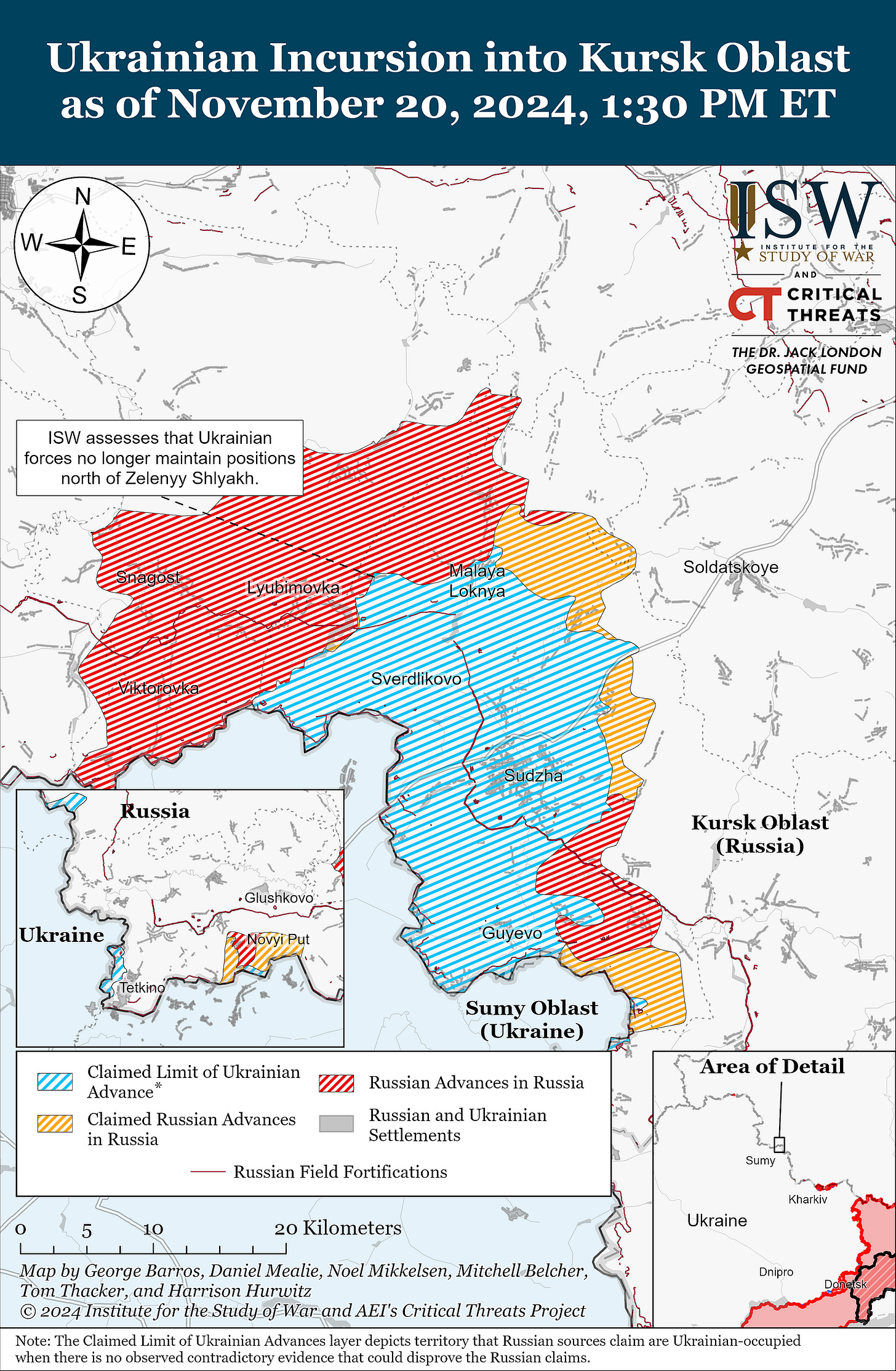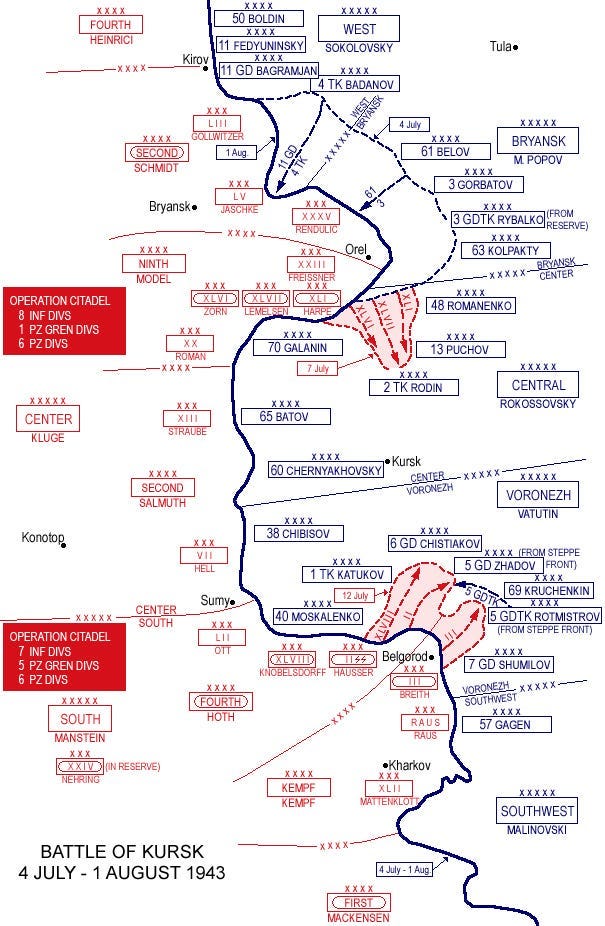The Battle of Kursk Echoes Today
Considering the Largest Battle in History
On August 6, 2024, Ukraine launched an incursion into Russia’s Kursk region, marking the largest foreign attack on Russian soil since Germany’s invasion of the Soviet Union during World War II. The attack has significant propaganda value, as the 1943 Battle of Kursk was the single largest battle in the history of warfare and is still commemorated in Russia as one of its greatest military victories. Ukraine’s leadership was very aware of this history.
The Eastern Front
In a 2017 Foreign Affairs essay, historian and Stalin biographer Stephen Kotkin recounted that earlier assault through the perspectives of two key figures: Joseph Stalin and Adolf Hitler. Stalin, who came to power in 1924, and Hitler, who rose to leadership in 1933, had lives that, according to Kotkin, “run in parallel.” “But it was the intersection that would matter: two very different men from the peripheries of their societies who were bloodily reviving and remaking their countries, all while unknowingly drawing ever closer.”
By the second year of World War II, missteps on both sides initiated a chain of events leading to one of history’s largest — and deadliest — military confrontations. “History is driven by the interaction of geopolitics, institutions, and ideas,” Kotkin wrote, “but it takes historical agents to set it all in motion.”
By the summer of 1941, Hitler seemed to have the upper hand, while Stalin adhered to the nonaggression pact signed by Germany and the Soviet Union in 1939. Rumors of a German attack circulated for months, stoking fears of an “imminent titanic war.” Stalin, however, was “driven by a blinding desire to avoid war at all costs” and dismissed “whatever he chose not to believe” as disinformation.
Thus, on June 22, 1941, when over three and a half million German and Axis troops launched Operation Barbarossa, Stalin, despite numerous warnings, was caught unprepared. Yet, Kotkin argued, “the question of who most miscalculated is not a simple one.” In expecting a swift victory over Moscow, Hitler had opened the eastern front, which ultimately doomed German forces. While the Soviet Union prevailed over Germany, the cost was both enormous and enduring.
The Journey to Kursk
By 1943, the Germans had suffered a major defeat at Stalingrad in Southern Russia, and the Soviet Red Army was gaining momentum on the Eastern Front. The Germans sought to regain the initiative with a decisive offensive. The Kursk salient, a 200-mile-wide and 100-mile-deep Soviet-held bulge in the front lines became the focal point for Germany’s planned counterattack.
The defeat at Stalingrad itself resulted from an ill-conceived German strategy to split their advance into Russia along two axes. One continued to push towards Moscow, and another diverted south towards the Russian oil fields in Southern Russia. Hitler intended to take the capital while cutting off a key supply chain for the Red Army. But, the Wehrmacht was repelled from Moscow and suffered over one million casualties in the failed offensive on Stalingrad.
The German Army retreated, and the Soviets began a relentless advance to drive back the Nazis across the vast steppes of European Russia. By the summer of 1943, the Germans had been pushed hundreds of miles towards the modern-day western border of Russia. Here, they would attempt to reverse their fortunes.
Named “Operation Citadel”, the German plan aimed to encircle and destroy Soviet forces in the Kursk salient using a pincer movement with attacks from the north and south. They would allow the Soviet army to advance about 100 miles into the front before attempting to outflank them. Germany amassed its best units, including elite divisions equipped with Panzer and Tiger Tanks, to achieve a breakthrough.
The Soviets, aware of German plans through intelligence operations, fortified the Kursk region with extensive defensive lines. Over 1.3 million soldiers, 20,000 artillery pieces, and thousands of tanks and aircraft were deployed to repel the attack. They built trenches, laid millions of mines, and created anti-tank defenses. The Soviets also had home-field advantage: this was their land and these areas had suffered massive civilian casualties at the hands of the German army.
The assembled forces were as follows:
Soviet Union: Approximately 1.9 million soldiers, over 5,000 tanks, 25,000 artillery pieces, and 2,900 aircraft.
Germany: Approximately 900,000 soldiers, over 2,700 tanks and assault guns, 10,000 artillery pieces, and 2,100 aircraft.
Battle of Kursk and Aftermath
The Germans attacked on July 5, 1943, with heavy tank assaults and air support. To the north, the German advance stalled due to stiff Soviet resistance and well-prepared defenses. In the south, the Germans achieved greater initial success, led by Field Marshal Erich von Manstein, but progress was slow and costly.
The climactic engagement of the German offensive was the Battle of Prokhorovka on July 12th. It was the largest tank battle in history involving about 1,200 tanks in chaotic, close-quarters combat. Here, the Soviets halted the German advance, inflicting heavy losses and preventing the breakthrough the Germans needed.
A Soviet counteroffensive followed, launched directly at the north and south salients of the German Army. They recaptured key territories, including the cities of Orel and Kharkiv, pushing the Germans into retreat. The Soviets relied on pure scale and manpower, employing massed artillery barrages and firing millions of rounds to blunt the German offensive.
The Battle of Kursk was a decisive turning point on the Eastern Front during World War II, marking the last major German offensive. Germany’s inability to achieve a breakthrough destroyed its capacity to conduct large-scale offensives for the remainder of the war. The Red Army seized the strategic initiative, which it would hold until the war’s conclusion following a relentless campaign culminating in the fall of Berlin in May 1945.
“Villages destroyed by fire, shattered towns, stumps of trees, cars bogged down in green slime, field hospitals, hastily dug graves — it all merges into one.” — Ilya Ehrenburg, Soviet Writer
The battle was one of the costliest of the war, with staggering losses on both sides. German forces suffered over 200,000 casualties and lost around 720 tanks and 680 aircraft. Soviet losses were even more severe, with over 250,000 soldiers killed or missing, more than 600,000 wounded, and approximately 1,500 tanks and 3,000 aircraft destroyed. Despite these heavy losses, the Soviet Union’s ability to replenish its forces and maintain the offensive demonstrated its growing industrial and military strength over Germany.
Strategically, the Battle of Kursk showcased the effectiveness of Soviet defensive and counteroffensive tactics, solidifying their dominance on the Eastern Front. The battle’s outcome not only marked a critical failure for Germany but also highlighted the shifting balance of power in the war. Kursk paved the way for the Soviet Union’s steady advance into Eastern Europe, playing a key role in the eventual Allied victory and reshaping the trajectory of World War II.
The 2024 Ukrainian Offensive
The Battle of Kursk is still commemorated, and it is regarded as one of the great military victories in Russian history and key to winning the Eastern Front, which in Russia is known as the “Great Patriotic War.” This was a major reason why Russia’s Kursk Oblast was chosen as the location of a surprise invasion by the Ukrainian army.
As of November 24, 2024, Ukraine’s incursion into Russia’s Kursk region, initiated in August, has significantly influenced the ongoing conflict. Designed to disrupt Russian military operations and obtain land to trade for Russian-occupied territory in Ukraine, the offensive initially secured 1,376 square kilometers. However, Russian counterattacks have reduced Ukrainian control to about 800 square kilometers.

Ukrainian forces have targeted key Russian military assets in the Kursk region, including advanced air defense systems. These strikes demonstrate Ukraine’s strategic use of precision-guided weapons to degrade Russian defenses. The attacks not only disrupt Russian military infrastructure but also signal Ukraine’s capacity to operate beyond its borders. Reports indicate approximately 11,000 North Korean troops are supporting Russian forces in Kursk. A high-ranking North Korean general was reportedly wounded in a Ukrainian strike.
Diplomatically, Ukraine’s use of Western-supplied long-range missiles has gained support. France recently approved the use of its Scalp missiles, aligning with similar decisions by the United States and the United Kingdom to allow the use of long-range precision munitions on Russian territory. This shift highlights growing Western endorsement of Ukraine’s ability to strike targets within Russia, despite the risks of escalation.
The incursion is ultimately small in scale, especially compared to the Ukrainian territory occupied by Russia. But the goal was not necessarily to conquer and hold territory. Firstly, Ukraine has demonstrated that a conventional attack on Russia’s territory will not provoke a nuclear response. This has made Ukraine’s Western allies more willing to remove restrictions on the use of their equipment.
Second, it gives Ukraine a bargaining chip during the eventual peace negotiations that can be traded for something of strategic significance, which is not necessarily territory. Third, it has demonstrated that Russia is spread too thin and has even had to rely on foreign troops to secure its territory. This has huge implications for Russia’s strategic position.
This has been shown by the sudden and rapid overthrow of Bashar Al-Assad in Syria and Russia’s apparent abandonment of its military base in Syria. The Assad regime was key for Russia’s power projection in the Middle East, but Russia had no flexibility in diverting resources to support it. In Georgia, we are seeing more aggressive popular uprisings. Weakening Russia in this way will ultimately help Ukraine secure its future.
Conclusion
Kursk again holds tremendous historical significance, this time in the first major European war since World War II. It has been chosen for the second time as a strategic point to reverse fortunes in a war involving Russia. The difference today, which illustrates the changing nature of warfare in the 21st century, is its significance lies in propaganda value and its psychological impact in other regions, rather than raw military power. However, the result will influence a new strategic order in Europe and the Middle East, just as in the great Battle of Kursk 80 years ago.






